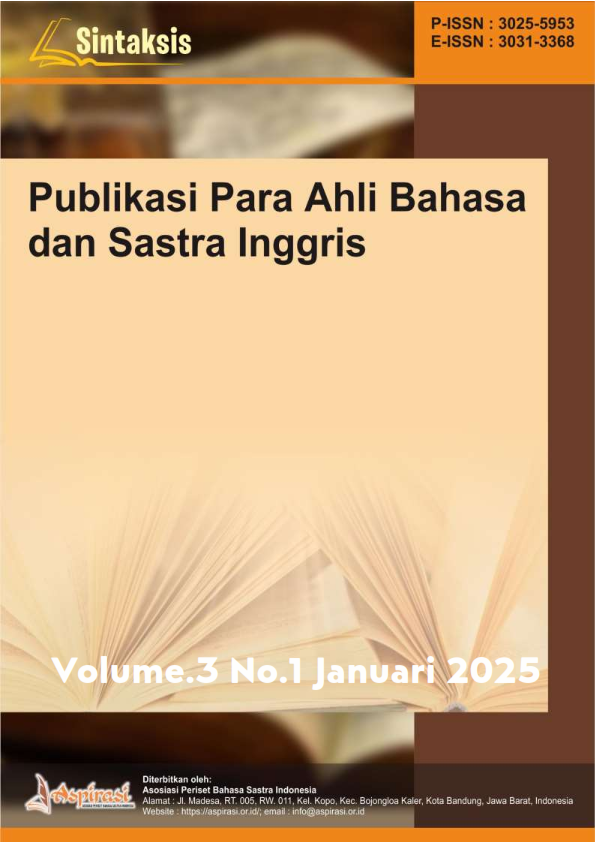Kritik Sosial dalam Film Berjudul Wicked: Sebuah Pendekatan Analisis Semiotik
DOI:
https://doi.org/10.61132/sintaksis.v3i1.1308Keywords:
social critique, semiotics, wicked film, character, stereotypesAbstract
The film "Wicked," adapted from the novel by Gregory Maguire, offered a new perspective on the character Elphaba, who was known as the wicked witch in the classic story "The Wizard of Oz." This research aimed to explore how Elphaba's character challenged the negative stereotypes associated with her and highlighted the importance of representing complex characters in media. This study was descriptive in nature, employing a semiotic approach to analyze the signs and meanings contained within Elphaba's character, as well as the social critique implications that arose. The findings indicated that Elphaba was not merely perceived as a symbol of evil but also served as a representation of empowerment for marginalized individuals, reflecting the complexities of identity and the struggle against social stigma. Elphaba's character illustrated a journey of transformation from ostracism to self-acceptance, inspiring audiences to understand and appreciate diversity and the challenges faced by those considered different. The film invited viewers to reflect on how societal judgments were often based on physical appearance and encouraged them to celebrate differences. The implications of this social critique were significant, as they could foster empathy and positive change within society, as well as raise awareness of the importance of embracing individual uniqueness.
Downloads
References
Angelou, M. (1993). Wouldn't Take Nothing for My Journey Now. New York: Random House.
Baker, C. (2010). The Power of Representation: The Role of Media in Shaping Identity. New York: Routledge.
Brown, B. (2012). Daring Greatly: How the Courage to Be Vulnerable Transforms the Way We Live, Love, Parent, and Lead. New York: Gotham Books.
Butler, J. (2004). Undoing Gender. New York: Routledge.
Chandler, D. (2007). Semiotics: The Basics. New York: Routledge.
Culler, J. (2001). Literary Theory: A Very Short Introduction. Oxford: Oxford University Press.
Ehrlich, P. R. (2000). Human Natures: Genes, Cultures, and the Human Prospect. Washington, D.C.: Island Press.
Fiske, J. (1987). Television Culture. London: Routledge.
Fiske, S. T. (2010). Social Beings: A Core Motives Approach to Social Psychology. New York: Wiley.
Goffman, E. (1963). Stigma: Notes on the Management of Spoiled Identity. Englewood Cliffs, NJ: Prentice-Hall.
Hall, S. (1997). Representation: Cultural Representations and Signifying Practices. London: Sage Publications.
Lorde, A. (1984). Sister Outsider: Essays and Speeches. Berkeley: Crossing Press.
Maguire, G. (1995). Wicked: The Life and Times of the Wicked Witch of the West. New York: HarperCollins.
Mandela, N. (1990). Long Walk to Freedom: The Autobiography of Nelson Mandela. Boston: Little, Brown and Company.
McRobbie, A. (2004). Young Women and Consumer Culture: An Introduction. London: Palgrave Macmillan.
Rokmansyah, R. (2016). Kritik Feminisme dalam Media: Dinamika Kekuasaan dan Representasi. Jurnal Studi Gender, 5(2), 123-135.
Schwartz, S. (2003). Wicked: The Musical. New York: Theatre Communications Group.
Steele, C. M. (2010). Whistling Vivaldi: How Stereotypes Affect Us and What We Can Do. New York: W.W. Norton & Company.
Sutrisno, A. (2020). Representasi Perempuan dalam Film: Analisis Stereotip dan Kompleksitas Pengalaman. Jurnal Ilmu Komunikasi, 8(1), 45-60.
Tutu, D. (2000). No Future Without Forgiveness. New York: Doubleday.
Yousafzai, M. (2013). I Am Malala: The Girl Who Stood Up for Education and Was Shot by the Taliban. New York: Little, Brown and Company.
Downloads
Published
How to Cite
Issue
Section
License
Copyright (c) 2024 Sintaksis : Publikasi Para ahli Bahasa dan Sastra Inggris

This work is licensed under a Creative Commons Attribution-ShareAlike 4.0 International License.





